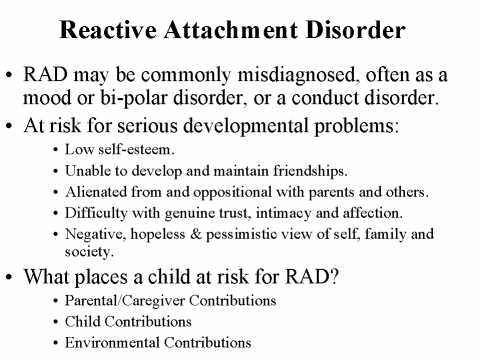

They typically will not reach out to others to start social relationships and may appear to be lacking in empathy toward others. Generally, Adult Attachment Disorder (AAD) is the result of an untreated childhood attachment disorder.Ī child with RAD displays inhibited (reserved and withdrawn) behaviors toward their primary caregiver, other adult caregivers, and adults in general. NOTE : Although this article deals exclusively with the two attachment disorders in children, it must be emphasized that attachment issues can affect adults, as well. Depending on the child's symptoms, their attachment disorder may be diagnosed as one of two distinct types: Reactive Attachment Disorder (RAD) or Disinhibited Social Engagement Disorder (DSED). Signs that an attachment disorder is present are usually evident from around the age of 9 months.

Attachment disorders prevent a child from forming loving and trusting emotional attachment bonds with a primary caregiver.Īttachment disorders have adverse effects on a child's moods, emotions, ability to socialize normally, decision-making ability, and behavior. An attachment disorder can also arise when the child experiences trauma or abuse or when a child has no consistent caregiver early in life.

They also contribute to the child's future ability to build healthy relationships and regulate their emotions in others' interactions.Īttachment disorders occur when a child experiences severe or prolonged emotional and physical neglect. Secure attachment bonds help the child in developing positive self-esteem and self-reliance. This, in turn, helps to build the child's confidence in exploring and experiencing the world. The child sees the caregiver as a reassuring constant in their life and comes to expect that that person will always be there to provide care, attention, and protection from harm. They also display what is considered to be a healthy level of stranger anxiety around people with whom they are unfamiliar. When attachment occurs, the child dislikes being separated from the primary caregiver and may cry in protest when this happens. The theory suggests that an infant who is loved, has their needs attended to in a timely fashion, and feels a sense of security, will naturally develop an attachment to their primary caregiver (in most cases, a parent).Īttachment to a primary caregiver typically occurs in infancy, before the child reaches their first birthday. The Attachment Theory was first proposed by John Bowlby, a British psychologist, psychiatrist, psychoanalyst, and child development specialist. However, we will begin by explaining the attachment theory, and the role attachment plays in normal child development. Steps that can prevent attachment disorders from developing in babies and young children will also be looked at. We will also highlight some conditions that tend to occur alongside an attachment disorder and tips for caregivers to help children build secure and nurturing attachment bonds. What follows is an in-depth look at these disorders, from types, causes, and symptoms to diagnosis, treatment, and outlook for affected children. The child's best possible outcome is achieved when the disorder is identified and treated as early as possible. This can negatively affect how the child develops and functions physically, socially, and emotionally.Īttachment disorders may be rare, but they are serious conditions that can have emotionally and socially debilitating effects. Attachment issues can arise however, if children experience multiple traumas or severe neglect of their needs. When children are reared in a loving and caring environment, they develop healthy, secure attachments to their parents or caregivers.


 0 kommentar(er)
0 kommentar(er)
